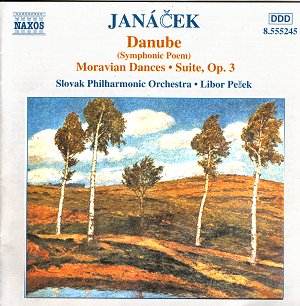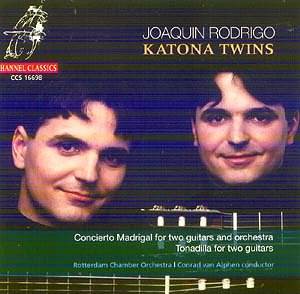 Composer: Leoš Janáček
Composer: Leoš Janáček
Works: Danube, Incidental music from Schluck und Jau, Moravian Dances, Suite, Op. 3
Performers: Slovak Philharmonic Orchestra, Libor Pešek (conductor), Jana Valašková (soprano), Zdeněk Husek (viola)
Recording: Recorded 1985 at the Concert Hall of the Slovak Philharmonic Orchestra, First released in 1986 on Marco Polo 8.220162. NAXOS 8.555245
Label: NAXOS
Leoš Janáček, a titan of early 20th-century music, is often celebrated for his operatic masterpieces, yet his orchestral works reveal a distinct and equally compelling voice that deserves attention. The present recording showcases a collection of Janáček’s orchestral pieces, framing the intricate interplay between his nationalistic influences and modernist sensibilities. The centerpiece, his symphonic poem Danube, emerges as a deeply evocative exploration of the river, which Janáček conceptualizes not merely as a geographical entity but as a feminine symbol imbued with emotional depth.
The Danube unfolds across four movements, each rich in impressionistic textures and thematic fluidity, allowing the listener to experience its ebb and flow akin to the river itself. The Slovak Philharmonic Orchestra, under the baton of Libor Pešek, navigates these waters with both precision and sensitivity. The orchestration is lush yet transparent, showcasing Janáček’s signature knack for color. In the first movement, the woodwinds introduce a delicate motif that suggests gentle ripples, while the strings build a more tumultuous undercurrent, reflecting the river’s dual nature. The engineering of this recording captures these nuances superbly, with a soundstage that allows each instrument to resonate clearly without overpowering the others.
A notable moment occurs in the third movement, where soprano Jana Valašková soars with an undulating, wordless melody reminiscent of Rachmaninov’s Vocalise. This moment is not only a highlight of the piece but also an instance of Janáček’s ability to blend operatic lyricism with orchestral texture. Valašková’s voice is both haunting and ethereal, seamlessly integrating with the orchestral fabric, and the lushness of the strings underneath her line enriches the emotional landscape.
The inclusion of incidental music from Schluck und Jau further illustrates Janáček’s versatility. While the pieces are brief, they pack a punch with their wit and charm, showcasing a lighter side of the composer. The orchestral colors are vibrantly rendered, with playful dynamics and lively rhythms that reflect the comedic nature of Hauptmann’s play. This allows the listener to appreciate Janáček’s ability to shift from the profound to the playful in a matter of minutes, further enhancing the album’s appeal.
The Moravian Dances, characterized by their rhythmic vitality and melodic simplicity, serve as a delightful contrast to the heavier thematic material of Danube. Here, Janáček’s affinity for folk elements shines through, as the orchestra executes each dance with a spirited authenticity that feels fresh and unpretentious. Pešek’s conducting draws out the nuances of these dances, allowing them to breathe naturally without succumbing to over-interpretation.
This recording stands out not only for its stellar performances but also for its thoughtful curation of Janáček’s lesser-known works. The engineering captures the orchestra’s dynamic range exceptionally well, highlighting the clarity and textural richness inherent in Janáček’s orchestration. While comparisons to other recordings of Janáček’s works are abundant, this particular album offers a compelling interpretation that balances historical fidelity with an invigorating freshness.
The Slovak Philharmonic’s interpretation of Janáček’s works is compelling and nuanced, reflecting the composer’s unique voice and cultural heritage. This recording represents a significant contribution to the understanding and appreciation of Janáček’s orchestral music, deserving a place in both the collections of enthusiasts and newcomers alike. Highly recommended for its artistry and insightful performances, it reaffirms Janáček’s stature alongside the greats of Czech music.



